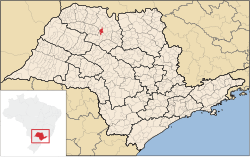Mirassol
| Mirassol | |||
|---|---|---|---|
| Municipality | |||
|
|||
 Location of Mirassol |
|||
| Coordinates: 20°49′08″S 49°31′15″W / 20.81889°S 49.52083°WCoordinates: 20°49′08″S 49°31′15″W / 20.81889°S 49.52083°W | |||
| Country |
|
||
| Region | Southeast | ||
| State |
|
||
| Government | |||
| • Mayor | José Ricci Júnior | ||
| Area | |||
| • Total | 243.161 km2 (93.885 sq mi) | ||
| Elevation | 587 m (1,926 ft) | ||
| Population (2010/IBGE) | |||
| • Total | 53,792 | ||
| • Density | 220/km2 (570/sq mi) | ||
| Time zone | UTC-3 (UTC-3) | ||
| • Summer (DST) | UTC-2 (UTC-2) | ||
| Postal Code | 15130-000 | ||
| Area code(s) | +55 17 | ||
| Website | Prefecture of Mirassol, São Paulo | ||
Mirassol is a municipality in the state of São Paulo, Brazil. The city is located in the northern part of the state, 453 km from the city of São Paulo and 15 km from São José do Rio Preto. Mirassol has 53,792 inhabitants (IBGE/2010).
The city belongs to the Microregion of São José do Rio Preto.
Mirassolândia, Ipiguá, São José do Rio Preto, Bady Bassitt, Nova Aliança, Jaci, Neves Paulista and Bálsamo
The city was founded on September 8, 1910, by Joaquim da Costa Penha, with the name of São Pedro da Mata Una. In November 27, 1919, the village changed its name to Mirassol, being elevated to district.
The city was officially established as a municipality in December 23, 1924.
Mirassol has a relevant furniture industry, and 30% of the city's GDP comes from the Secondary sector. Commerce and services corresponds to 68% of the Economy.
The HDI, measured by the UNDP, was 0.822 in the year 2000. The life expectancy for the city is 75.42 years. The literacy rate, measured in 2000 by SEADE, was 92.35%.
There weren't homicides in the year 2008. In 2007, Mirassol had 1 homicide.
All statistics are from SEADE and IBGE.
The city is linked with the SP-310 (Rodovia Washington Luis) and SP-320 (Rodovia Euclides da Cunha) state highways. Mirassol has an airport for small planes.
...
Wikipedia


